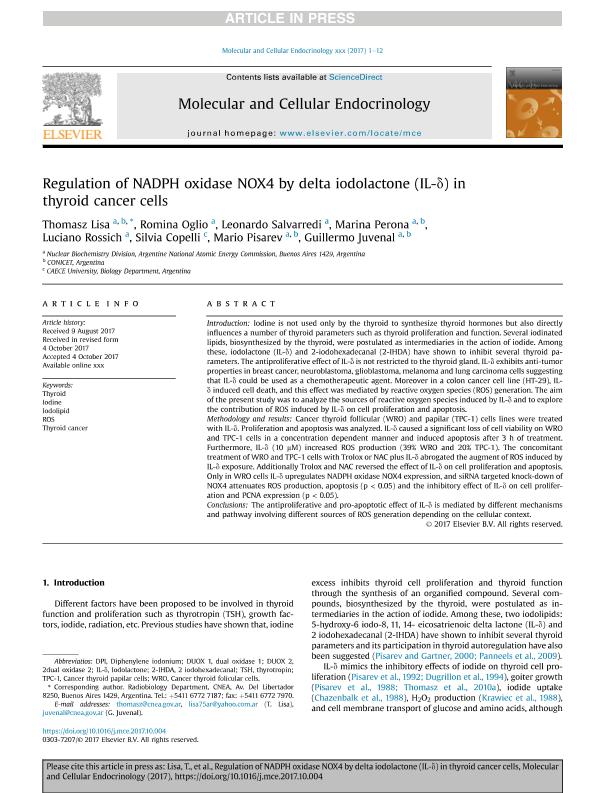Mostrar el registro sencillo del ítem
dc.contributor.author
Thomasz, Lisa

dc.contributor.author
Oglio, Andrea Romina

dc.contributor.author
Salvarredi, Leonardo Andres

dc.contributor.author
Perona, Marina

dc.contributor.author
Rossich, Luciano Esteban

dc.contributor.author
Copelli, Silvia Beatriz

dc.contributor.author
Pisarev, Mario Alberto

dc.contributor.author
Juvenal, Guillermo Juan

dc.date.available
2018-04-16T18:03:43Z
dc.date.issued
2017-10
dc.identifier.citation
Thomasz, Lisa; Oglio, Andrea Romina; Salvarredi, Leonardo Andres; Perona, Marina; Rossich, Luciano Esteban; et al.; Regulation of NADPH oxidase NOX4 by delta iodolactone (IL-δ) in thyroid cancer cells; Elsevier Ireland; Molecular and Cellular Endocrinology; 10-2017; 1-12
dc.identifier.issn
0303-7207
dc.identifier.uri
http://hdl.handle.net/11336/42158
dc.description.abstract
Introduction: Iodine is not used only by the thyroid to synthesize thyroid hormones but also directly influences a number of thyroid parameters such as thyroid proliferation and function. Several iodinated lipids, biosynthesized by the thyroid, were postulated as intermediaries in the action of iodide. Among these, iodolactone (IL-δ) and 2-iodohexadecanal (2-IHDA) have shown to inhibit several thyroid parameters. The antiproliferative effect of IL-δ is not restricted to the thyroid gland. IL-δ exhibits anti-tumor properties in breast cancer, neuroblastoma, glioblastoma, melanoma and lung carcinoma cells suggesting that IL-δ could be used as a chemotherapeutic agent. Moreover in a colon cancer cell line (HT-29), IL-δ induced cell death, and this effect was mediated by reactive oxygen species (ROS) generation. The aim of the present study was to analyze the sources of reactive oxygen species induced by IL-δ and to explore the contribution of ROS induced by IL-δ on cell proliferation and apoptosis. Methodology and results: Cancer thyroid follicular (WRO) and papilar (TPC-1) cells lines were treated with IL-δ. Proliferation and apoptosis was analyzed. IL-δ caused a significant loss of cell viability on WRO and TPC-1 cells in a concentration dependent manner and induced apoptosis after 3 h of treatment. Furthermore, IL-δ (10 μM) increased ROS production (39% WRO and 20% TPC-1). The concomitant treatment of WRO and TPC-1 cells with Trolox or NAC plus IL-δ abrogated the augment of ROS induced by IL-δ exposure. Additionally Trolox and NAC reversed the effect of IL-δ on cell proliferation and apoptosis. Only in WRO cells IL-δ upregulates NADPH oxidase NOX4 expression, and siRNA targeted knock-down of NOX4 attenuates ROS production, apoptosis (p < 0.05) and the inhibitory effect of IL-δ on cell proliferation and PCNA expression (p < 0.05). Conclusions: The antiproliferative and pro-apoptotic effect of IL-δ is mediated by different mechanisms and pathway involving different sources of ROS generation depending on the cellular context.
dc.format
application/pdf
dc.language.iso
eng
dc.publisher
Elsevier Ireland

dc.rights
info:eu-repo/semantics/openAccess
dc.rights.uri
https://creativecommons.org/licenses/by-nc-sa/2.5/ar/
dc.subject
Iodine
dc.subject
Iodolipid
dc.subject
Ros
dc.subject
Thyroid
dc.subject
Thyroid Cancer
dc.subject.classification
Otras Ciencias Biológicas

dc.subject.classification
Ciencias Biológicas

dc.subject.classification
CIENCIAS NATURALES Y EXACTAS

dc.title
Regulation of NADPH oxidase NOX4 by delta iodolactone (IL-δ) in thyroid cancer cells
dc.type
info:eu-repo/semantics/article
dc.type
info:ar-repo/semantics/artículo
dc.type
info:eu-repo/semantics/publishedVersion
dc.date.updated
2018-04-16T14:40:50Z
dc.journal.pagination
1-12
dc.journal.pais
Irlanda

dc.journal.ciudad
Shannon
dc.description.fil
Fil: Thomasz, Lisa. Consejo Nacional de Investigaciones Científicas y Técnicas; Argentina. Comision Nacional de Energía Atómica. Gerencia de Área de Aplicaciones de la Tecnología Nuclear. División Bioquímica Nuclear; Argentina
dc.description.fil
Fil: Oglio, Andrea Romina. Consejo Nacional de Investigaciones Científicas y Técnicas; Argentina. Comision Nacional de Energía Atómica. Gerencia de Área de Aplicaciones de la Tecnología Nuclear. División Bioquímica Nuclear; Argentina
dc.description.fil
Fil: Salvarredi, Leonardo Andres. Consejo Nacional de Investigaciones Científicas y Técnicas; Argentina. Comision Nacional de Energía Atómica. Gerencia de Área de Aplicaciones de la Tecnología Nuclear. División Bioquímica Nuclear; Argentina
dc.description.fil
Fil: Perona, Marina. Consejo Nacional de Investigaciones Científicas y Técnicas; Argentina. Comision Nacional de Energía Atómica. Gerencia de Área de Aplicaciones de la Tecnología Nuclear. División Bioquímica Nuclear; Argentina
dc.description.fil
Fil: Rossich, Luciano Esteban. Consejo Nacional de Investigaciones Científicas y Técnicas; Argentina. Comision Nacional de Energía Atómica. Gerencia de Área de Aplicaciones de la Tecnología Nuclear. División Bioquímica Nuclear; Argentina
dc.description.fil
Fil: Copelli, Silvia Beatriz. Universidad Centro de Altos Estudios en Ciencias Exactas; Argentina
dc.description.fil
Fil: Pisarev, Mario Alberto. Consejo Nacional de Investigaciones Científicas y Técnicas; Argentina. Comision Nacional de Energía Atómica. Gerencia de Área de Aplicaciones de la Tecnología Nuclear. División Bioquímica Nuclear; Argentina
dc.description.fil
Fil: Juvenal, Guillermo Juan. Consejo Nacional de Investigaciones Científicas y Técnicas; Argentina. Comision Nacional de Energía Atómica. Gerencia de Área de Aplicaciones de la Tecnología Nuclear. División Bioquímica Nuclear; Argentina
dc.journal.title
Molecular and Cellular Endocrinology

dc.relation.alternativeid
info:eu-repo/semantics/altIdentifier/doi/http://dx.doi.org/10.1016/j.mce.2017.10.004
dc.relation.alternativeid
info:eu-repo/semantics/altIdentifier/url/https://www.sciencedirect.com/science/article/pii/S0303720717305245
Archivos asociados
